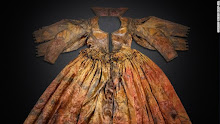I recently saw in Bride
magazine online a new article: “51 Something Blue Accessory Ideas for Your Wedding Day”—lots of sexy blue shoes, neat
little clutch-bags, drop earrings that looked more “honeymoon” than “wedding gown,”
lacy lingerie, even blue-trimmed sunglasses! Calling the Something Old, Something New bridal ritual “an age-old tradition”
(it’s not!), the article, like so many about modern weddings, was full of
fashion fluff and low on womanly depth. Fashion ideas for your wedding can be fun, but sometimes it overshadows the real focus
In that spirit, I want to share an excerpt from my first book,
The Bride’s Ritual Guide: Look Inside to Find Yourself, that focuses on the Something
Old, Something New bridal rhyme, with a modern yet folkloric—and very feminine—twist! In the book, I call the something blue part of the bridal ritual: "Something intimate and magical. A sweet and tender connection to something divine; a reminder of the depth and eloquence of love without conditions." See below for more something history....
Wedding traditions, to borrow a
phrase from Carol McD. Wallace in her book All Dressed in White, have “complicated
roots.”
Take the rhyme, “Something old,
something new, something borrowed, something blue, and a sixpence for your shoe”—the familiar little verse that
became a beloved personal ritual for generations of brides. The rhyme itself
may not be that old, but the customs it describes have been around for centuries.
In cultures worldwide and for as long as we know, there was some sort of
superstitious custom for brides to tuck a little token of abundance (pieces of
bread, a lump of sugar, coins, a bit of ribbon, a silver charm) into their
purse, glove, or shoe or sew the items into the hem of their dress. This was all
done in the desire to call forth good luck, great fortune—including lots of
healthy children—or some magical promise of love forever!
Shoe historian Cameron Kippen reminds
us that “a long standing bridal superstition stated no harm could befall a
bride wearing blue.” Through the ages, wide-ranging references to the color
blue surround it with compelling and even divine properties. The color is often
associated with the Virgin Mary and is cited in Geoffrey Chaucer’s fourteenth
century “The Squire’s Tale” from The
Canterbury Tales as a symbol of truth and faithfulness.
With such rich folkloric history, it
stands to reason that somewhere along the way, some sentimental poet put it all
together in a romantic rhyme. A rhyme composed, perchance, as a gift to an
adored bride, her name unknown to us now, but like brides before and since,
their images became an icon of womanhood.































